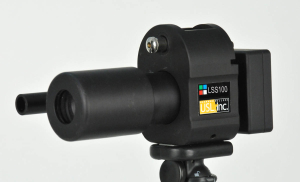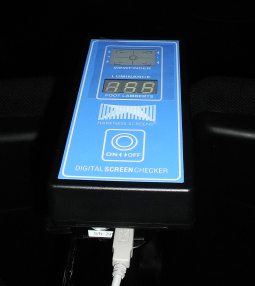In the film projector days, it was mandatory for the projectionist to walk by the projector several times per showing to adjust the focus of the lens. For many reasons, mostly dealing with heat stability and the elimination of the sometimes tight/sometimes loose film track, this isn’t required anymore. It is common for focus to remain astoundingly stable over months. Relative color problems have also gone from potentially horrid – as owners stretched a bulb far past its prime – to nuanced imperfections as xenon bulb technology was refined for digital life. No longer do we see the blues disappear and the white point slip so that the yellows turn brown…well, we can, but not often nor nearly as bad as it often was.
Bulbs don’t burn out perfectly though. The remains of a burned out bulb will show the darkening residue from the tungsten electrode (the anode) coating the inside of the glass and pits where arc bounces around giving the effect of ‘bulb flicker’, often long before its the mandatory death date. (Jim Slater has an excellent article in Cinema Technology if anyone needs a refresher course in xenon bulbs. Oram Eichstätt – The home of the XBO) (Cinema Equipment Sales has a reprint of a well done Ray Boegner piece: Everything you wanted to know about xenon bulbs…)
The loss of a skilled and caring pair of eyes on the screen before and during the movie (or alternative content) presentation is a loss regardless of how good the equipment is. This Quality Assurance problem was mentioned for the first time in recent memory during a CinemaCon 2015 seminar, The Unintended Consequences of Digital Cinema. Most usually these seminars have a billion years of expertise on stage, but in an effort to be polite to competitors onstage and customers who chose competitor’s products, many speakers leave trails too nuanced to parse. In this case, Carolyn Giardina – Contributing Editor of The Hollywood Reporter – prompted the panel, especially Rich Phillips – CTO of Arts Alliance – to speak clearly about quality assurance errors that are slipping by, to the extent that some exhibitors figure it is acceptable of the audience to be QA examiner in the non-premium rooms.
Quelle Horreur~!
Just in time, Harkness comes through with an iPhone app that works to get eyes in the room, and measure the screen with ease. They bill their new Digital Screen Verifier as the “World’s Most Accurate Light Meter App for the iPhone”. They will be selling this $40 iOS-only app alongside the handheld device that they introduced a few years ago. Here’s more of their verbiage:
Utilising pioneering proprietary technology, the Digital Screen Verifier from Harkness Screens is a unique utility for iPhones that allows cinema engineers and exhibitors to ensure that brightness levels in digital cinema are regular checked and maintained. Quick and easy to use, this relatively accurate (+/- 1fL) low-cost light measurement tool allows brightness readings to be taken (in foot lamberts) using white test patterns from a digital cinema projector. Its unique functionality allows light readings taken in the field to be directly imported into Harkness’ cloud-based Digital Screen Archiver tool in real-time to form a semi-automated entry-level solution to screen monitoring and auditorium maintenance.
They showed this at CinemaCon, but it took a couple extra weeks to become available at the Apple AppStore, but with all the Barco Laser and DolbyVision announcement sucking all the juice from the potential customer’s technology bandwidth it may be just as well that they can legitimately re-introduce this cool stuff as a follow up item.
They also followed up on an earlier announcement that they are working to put the Qalif products from Highlands Technology into the cinema. The Qalif Calibration system is an incredible piece of kit. And the follow-up tool will be a nice monitoring device for those who can’t afford to put a microphone in the sound field and limit their needs to what is available from the back wall. Bottom line is that Post Installation Quality Assurance is getting a major boost from a market leader.


